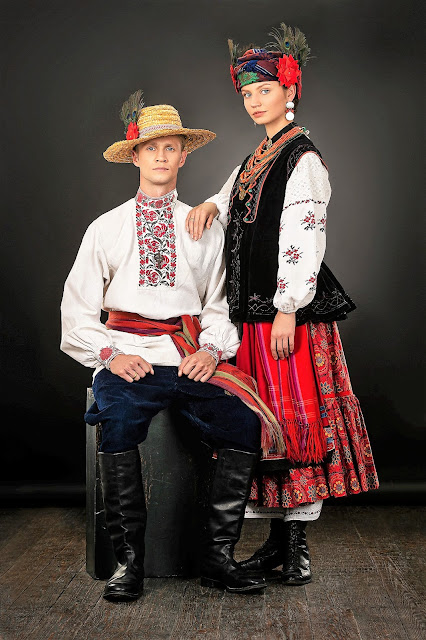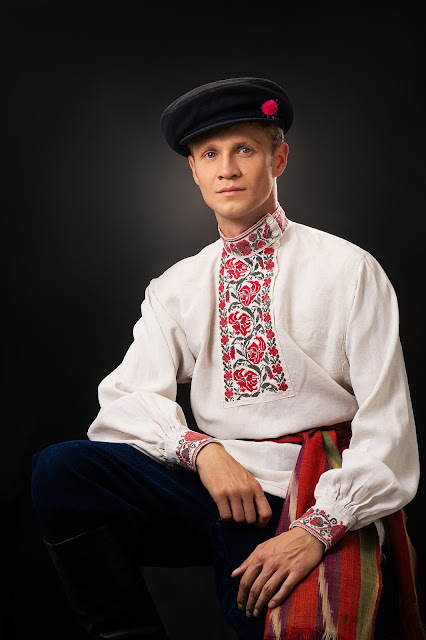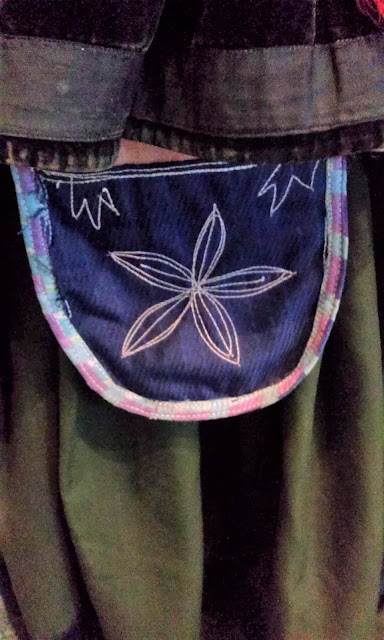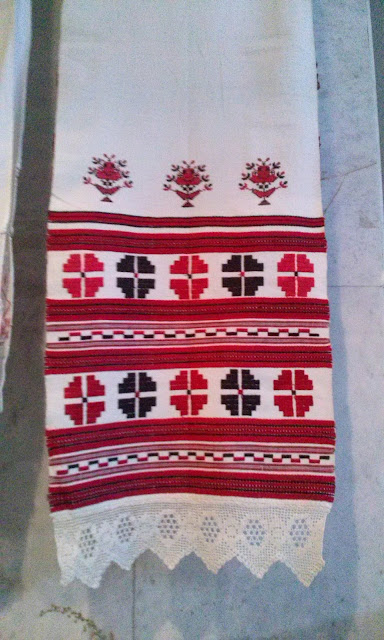Hello all,
In consideration of the current atrocities being perpetrated by Putin, I will interrupt my discourse on Netherlandic costumes and talk about the region of Luhansk, in eastern Ukraine. The above exhibit is from the Luhansk Kraievedchesky Museum. The four outfits on the left are from that region. The one on the right is a beautiful example of a Central Lemko costume, possibly from around the village of Hrab. I assume that it was donated by someone who had been forced out of Lemkovyna during Operation Visla and settled in Luhansk.
The chemise, or sorochka, of Luhansk is in line with the typical chemise worn in central and eastern Ukraine. It is of ustawka cut, with full sleeves, and embroidery on the collar, shoulder insets, sleeves, cuffs and hem. The techniques used are cross stitch, cutwork, counted satin stitch, darning stitch, joining stiches [merezhuvannia], and others. A number of the cross stitch designs are executed in red and blue, rather than the more usual red and black. Some cross stitch designs may be combined with white on white cutwork embroidery, which is unusual in other parts of Ukraine.
The vest, or kersetka is relatively short, but full around the bottom, being pleated at the waist in back. It is decorated with buttons, ribbon, rickrack and topstitching. A skirt, relatively full and long, is worn, often from patterned materials, An embroidered linen apron is included, as is a sash, lots of jewelry, a crown for brides and a cap for married women. A couple of the older outfits in the museum include plakhtas. Outerwear includes heavy wool coats, shawls and scarves. Note the embroidery on the shoulders of this first image is in nyz, which is more typical of Podillia. Several influences can be seen in the embroidery of this region.
Here are professional photos of a pair of costumes from Starobil'sky raion. It also shows the man's costume, which is typical for eastern Ukraine. One thing to notice is that in Ukrainian men's shirts, even when the opening is on the left, the embroidery is always centered. In Russian men's shirts the opening is almost always on the left, and usually the embroidery is centered on the opening. The female model shows us both the single woman's headdress and the married woman's cap. Notice the embroidery on the woman's sorochka combines white on white openwork, in this case, eyelets, with colored cross stitch embroidery. This is often done in Luhansk. The sash is rather wide, and woven on a loom. The ends look like they have some chain stitch embroidery on them. The skirt is made of printed cotton, and unusually, has a flounce. The apron is made of colored cloth and is ornamented with ribbons.
Here is an ensemble from the Luhansk Museum from the Bilokurakyne region.
Here we see a green skirt with a wide velvet band appliqued near the hem, a black kersetka ornamented with black ribbon and buttoned in the center, a sewn pocket with topstitched ornament, a married woman's cap, or chepets, shawl, and a sash, either finger-woven or of sprang. This outfit would be normally worn with an apron.
The shoulder and sleeve of the chemise is covered with unusual embroidery. It consists of white on white counted satin stitch, [lyshtva], combined with red and black eyelets scattered throughout the design. This would have been worn by a married woman old enough to not wish to wear cutwork, but still young enough to use extensive embroidery. The combination of whitework with red and black scattered motifs is more typical of Chernyhiw. It seems to be unique in this collection.
Here we can see that the shoulder inset is attached to the sleeve with a joining stitch, [merezhuvannia], which is worked on neither pieces, but rather between them, the closest that Ukrainians get to making lace. Notice also that the sleeve is smocked in the center, to give it extra fullness.
Here is another ensemble from the museum, from the same region. This one consists of a red skirt, blue apron, sash, black kersetka with rickrack and topstitching, a black pocket which also has topstitching, and a black shawl.
The embroidery on the chemise is more typical of Luhansk. From the front, what is visible is beautiful white on white cutwork and counted satin stitch embroidery.
The sleeve is made of 1 1/2 widths of home woven linen, thus there is a seam on the back. This seam features a decorative joining, and is flanked by two rows of bright red and blue cross stitch embroidery which is only visible from the rear. This is a feature very common in Luhansk costumes. There is red and black cross stitching on the cuff.
I will close with some images of rushnyky from this region. In my next article, I will show
closeups of the embroidery of a number of women's shirts from Luhansk.
This last is a rushnyk for easter, with 'Christ is Risen' embroidered on it.
Thank you for reading, I hope that you have found this to be interesting and informative. I especially hope that some will take embroidery motifs found here and in my next article, and make a remembrance of Luhansk, offering prayers for the safety of Ukraine with every cross embroidered on the cloth.
Roman K.
email: rkozakand@aol.com






















































Thank you so much for sharing this!!
ReplyDeleteДяка Вам за статтю!
ReplyDeleteЛуганськ - це Україна 🇺🇦💙!
Дякую вам за працю! А я мотивом луганської сорочки ( хміль із люверсами червоно-чорними) вишила своєї бабусі Сальвини довгу сорочку із льону, виткану нею власноруч. Я її трішки апгрейдила і ношу яу сукню. Бабуся була із Житомирщини і там теж вирощували хміль, я ще пам'ятаю.
ReplyDeleteNIce!
ReplyDeleteSuch a helpful article! I was confused about some of these concepts, but after reading your post, it all makes sense now. Please keep sharing this type of content.
ReplyDeleteprp treatment lahore
"I appreciate how well-researched this blog is. Your analysis on [topic] was not only informative but also thought-provoking. I’ll definitely be coming back for more."
ReplyDeletebuy online pet food
Such a great article!
ReplyDeleteDecent work!
ReplyDeleteEmbroidery for garments ensures a clean, sophisticated look that lasts for years.
ReplyDeletePlease credit @luhanshchyna on pinterest for the schemes of the embroidery as she was the one to make them
ReplyDeleteAmazing work!
ReplyDelete"Your perspective on this topic is so unique. I really appreciate it!"
ReplyDeleteBehavioral health specialist
This blog post is both informative and motivating. I learned a lot and feel inspired to apply these ideas.
ReplyDeleteBone fracture treatment in Lahore